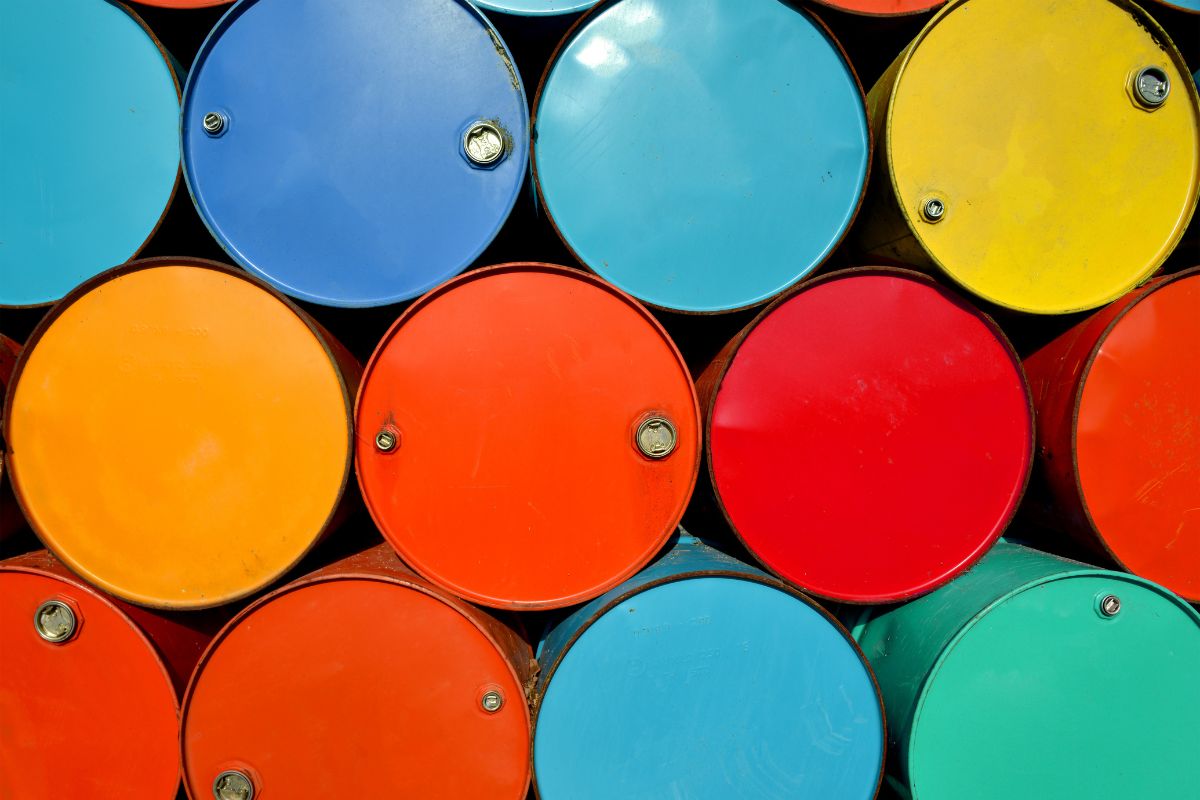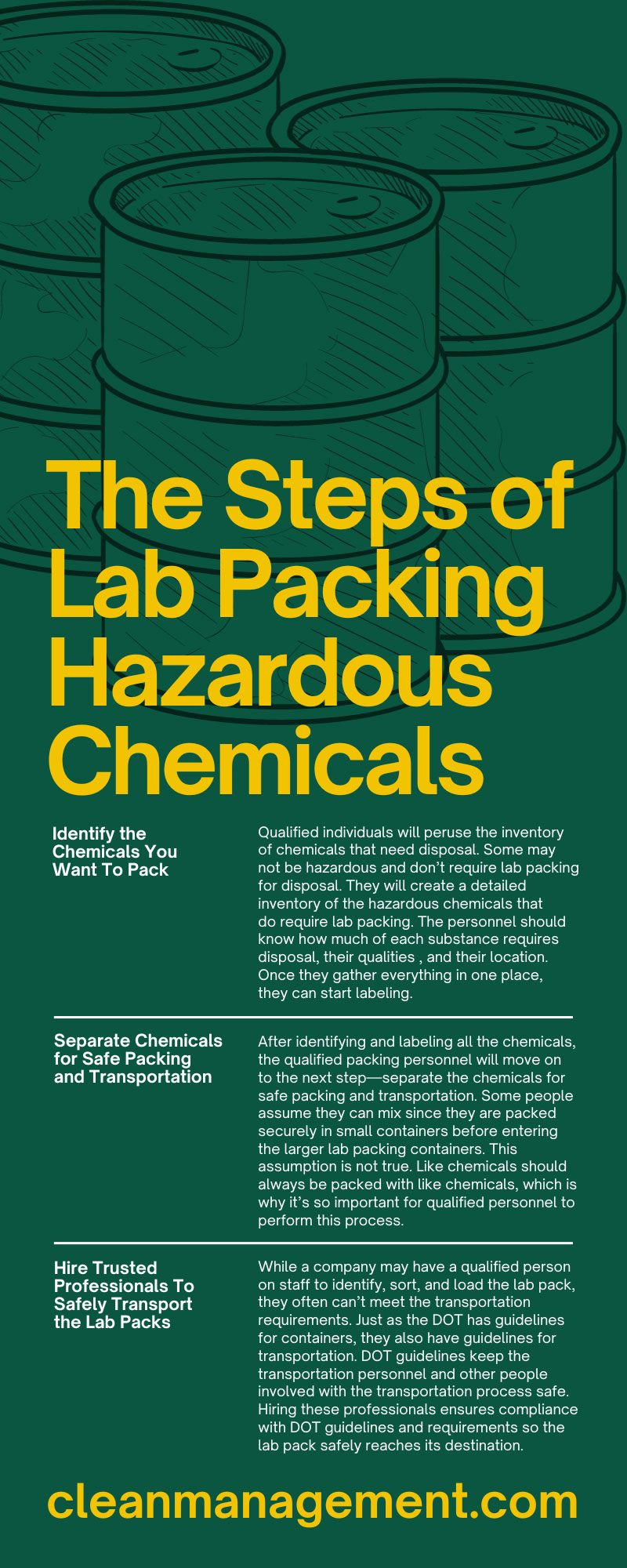The 5 Steps of Lab Packing Hazardous Chemicals

Businesses and organizations across various industries use or create hazardous chemicals, including schools using toxic substances in chemistry labs and auto repair shops using them for car maintenance. When they are no longer in use or require disposal, they must go somewhere.
Where do they go, and how do they get there? Their chemical qualities, such as flammability, determine their end location. Someone must lab pack the hazardous substances to get them to that end location for safe disposal. Qualified people within the business or organization using them can lab pack chemicals or hire professionals. Regardless of their affiliation, they will follow the five steps of lab packing hazardous chemicals.
Step 1: Identify the Chemicals You Want To Pack
The first step of lab packing anything, especially hazardous chemicals, is proper identification. Only qualified personnel can identify chemicals for lab packing. The qualifications include intimate knowledge of hazardous substances, packing procedures, and other guidelines within their industry.
Qualified individuals will peruse the inventory of chemicals that need disposal. Some may not be hazardous and don’t require lab packing for disposal. They will create a detailed inventory of the hazardous chemicals that do require lab packing. The personnel should know how much of each substance requires disposal, their qualities , and their location. Once they gather everything in one place, they can start labeling.
Resource Conservation and Recovery Act Provides a Helpful Coding System
Hazardous chemical labels for lab packing should be as detailed as possible. Anyone who picks up a container should know exactly what is in it and what the packed chemicals are capable of. The Resource Conservation and Recovery Act (RCRA) provides a standardized coding system so anyone can read and understand detailed labels. Combinations of letters and numbers indicate different qualities, such as D001 for flammable liquids.
Step 2: Separate Chemicals for Safe Packing and Transportation
After identifying and labeling all the chemicals, the qualified packing personnel will move on to the next step—separate the chemicals for safe packing and transportation. Some people assume they can mix since they are packed securely in small containers before entering the larger lab packing containers. This assumption is not true. Like chemicals should always be packed with like chemicals, which is why it’s so important for qualified personnel to perform this process.
Most People Separate Based on Chemical Type
Like chemicals means chemicals of the same type. There are four types of hazardous chemicals: ignitable, corrosive, toxic, and reactive. Some are flammable, some cause rust or decomposition, some poison living things, and some explode. Separating these types of substances is necessary because their combination is even more dangerous than when they’re alone. Can you imagine what could happen if something flammable mixed with something explosive?
Step 3: Pack Chemicals in Approved Containers
After the qualified personnel separate chemicals accordingly, they can start packing them. Most chemicals are already in small containers. If the small container is durable and airtight, the appointed packager may leave them in their original container and place them within the larger lab pack container. However, if the hazardous material is in an unsafe container, especially one that may break during transport, then the worker may need to repackage it in a small container before storing it in the approved lab pack container.
The US Department of Transportation Has Container Guidelines
The Department of Transportation (DOT) determines the qualities of an approved container. Approved containers vary per industry, but most of the standards focus on durability. Containers should be able to withstand the vibrations they experience during travel, survive extreme temperatures, and prevent spills or fires. This often means metal drums or barrels for lab packs. The DOT has approved containers made from other materials, such as wooden boxes, for circumstances when it is safe to use them.
Step 4: Hire Trusted Professionals To Safely Transport the Lab Packs
While a company may have a qualified person on staff to identify, sort, and load the lab pack, they often can’t meet the transportation requirements. Just as the DOT has guidelines for containers, they also have guidelines for transportation. DOT guidelines keep the transportation personnel and other people involved with the transportation process safe. Hiring these professionals ensures compliance with DOT guidelines and requirements so the lab pack safely reaches its destination.
A Turnkey Hazardous Waste Professional Will Determine the Best End Destination
Where is the end destination for a business or organization’s lab pack? The hazardous waste professionals will determine that location based on the types of chemicals they transport and local, state, and federal requirements. Often, the substances must go through a neutralization or stabilization process before disposal. Sometimes, they can go through these processes at the end disposal destination, but these safety processes often occur offsite. A turnkey hazardous waste professional will make this stop before finishing the transportation and disposal process.
Step 5: Trusted Professionals Safely Dispose of Lab Packs
When the hazardous chemical lab packs are safely in the hands of trusted waste professionals, they will handle the disposal process. As we explained above, the pros may need to take the lab packs to a facility for additional safety measures before disposal. Regardless of whether they need to take this extra step, they will follow the waste until the end of the disposal process. The business or organization that hired the professionals should receive confirmation of proper disposal.
Hazardous Waste Professionals Will Finish the Disposal Process
A turnkey hazardous waste professional can perform every step of the lab lack process, from identification to disposal. You can often hire them specifically for the final stages when the waste leaves your business or organization. These professionals will finish the disposal process for you so you can rest assured that the hazardous materials were processed safely and correctly.
The five steps of the lab packing hazardous chemicals process are identification, separation, packing, transportation, and disposal. Businesses or organizations can handle the beginning steps themselves or hire professionals for lab pack services. Clean Management Environmental Group are turnkey hazardous waste experts and will gladly handle this process for you.

